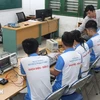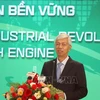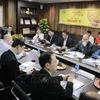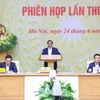Developing high-tech agriculture is an important task and also the inevitable trend of Vietnam’s socioeconomic development strategies in the context of deeper international integration, the Nhan Dan (People) online newspaper said.
Practice has proved that an effective agricultural development model with application of high technology can foster the economy and bring big profits to producers.
However, to promote the economic strength of agriculture, it is necessary to have specific orientations, mechanisms and policies to attract relevant economic sectors and scientific enterprises to invest in technological innovation and high-tech applications for agricultural production.
Across more than two decades of undergoing the Doi Moi (renovation) process, Vietnam’s agriculture sector has witnessed positive changes and dramatically shortened the gap to other economies with advanced agricultural sectors. However, when the speed of international integration is accelerated, the gap seems to widen.
In recent years, agricultural exports, the field that seemingly reflects Vietnam’s agriculture potential most accurately, has generated ‘manipulated’ figures. In 2013, total exports of agricultural and fishery products reached 19.8 billion USD, accounting for 15 percent of the nation’s total exports.
In the first quarter of 2014, exports of agricultural products nationwide reached 6.9 billion USD, up 9.4 percent compared to the same period in 2013.
However, those flashy numbers, according to expert assessments, did not truly result from Vietnam’s success in increasing agricultural productivity and product quality, but rather reflect that the world market faced supply shortages. As a result, importers had to pay a higher price and Vietnam still sold their crops under crude productions.
The reason for this inadequacy is explained as follows.
Currently, despite the application of advanced technologies to agriculture, efficiency remains modest. Farmers still rely heavily on experience to grow their crops. That is the reason for low innovation in agricultural products, causing great difficulties for the sector in the international integration process and reducing the competitiveness of agricultural products on the international market. As there is low productivity increase in agricultural production, Vietnam accepts selling raw and at low prices such agricultural commodities as coffee, rubber and rice.
Agricultural production is still spontaneous and fragmented, with high production costs. The first evidence for that comes from the cultivation sector.
In the northern region, it is not strange to realise that each household cultivates on multiple various sizes of fields, both large and small, making it hard to effectively apply technological advances in production and investment designed for a large specialised and concentrated agricultural production area. It also lays an impediment to the sector’s industrialisation and modernisation processes.
Meanwhile, the livestock industry has fallen into dispersion, and a lack of concentration in production makes it difficult to deal with disease control, to consume products and to offer materials for the processing industry. The costs for feeding products and breeds are still high, while feeding livestock with traditional products is ineffective and yields low productivity. That livestock are fed with processed feeding products leads to the high prices of animal source foods, which are at a higher level in comparison with the sector’s potential.
The processing industry plays an important role in agricultural production, but continues to lag behind. Agricultural products are not well processed or well preserved, leading to lower prices of especially seasonal products like lychee, longan, catfish - even rice and coffee.
In particular, international integration also generates an increasingly fierce level of competition and a high dependence on the global market within Vietnam’s agricultural sector.
This is clearly manifested in the dependence on foreign markets when the first and foremost concern is the consumption market for Vietnamese agricultural products, then the market for production factors - such as seeding, fertilisers, plant protection products, and agricultural technologies. Each fluctuation on the global market will have a great impact on product prices, output, and quality.
However, it is noteworthy that, despite such problems, agriculture is still the leading economic platform and is expected to continue underpinning the entire national economy as it faces great uncertainty.
Dr. Dang Kim Son, Director of the Institute of Policy and Strategy for Agriculture and Rural Development, emphasised that Vietnam's agriculture continues to play an outstanding role in helping the country maintain economic growth in difficult circumstances, especially given the impacts of the global economic crisis.
But what would be the ‘cure’ for this pillar’s difficulties? This, too is an interesting question that requires an urgent answer.
In search of answers, at a conference discussing rice production and consumption held in the Mekong Delta city of Can Tho in mid-March, Prime Minister Nguyen Tan Dung stressed that the Party and State always pay special attention to agriculture, farmers, and rural areas, affirming these as the top concern in national strategic policies.
Agriculture is a foundation, a development axis, and a strong pillar of the economy. Over the years, the sector has recorded continuous growth with important achievements, contributing to nationwide economic stability, reducing poverty and improving the living standards of the people.
However, the PM also said that agricultural growth tends to slow down, while agricultural labourers still face difficulties to earn their living. The reason lies in high production costs, lower selling prices of agricultural products, and low labour productivity, he noted.
Therefore, it is necessary to restructure the country's agriculture towards sustainable and effective development, while increasing income and improving living standards for rural residents and farmers should be associated with the building of new-style rural areas.
Local authorities should create favourable conditions to encourage the application of advanced technologies and machinery in agricultural production in order to reduce costs and improve the productivity, quality, and competitiveness of agricultural products. “It is the most decisive work in agricultural restructuring,” the PM stressed.
Science and technology have been flagged as an effective solution for agricultural development, yet, the urgent task should be carried out in the coming future is establishing an effective roadmap for the sector’s development to help the sector promote its important role of the economy’s strong pillar.-VNA
Practice has proved that an effective agricultural development model with application of high technology can foster the economy and bring big profits to producers.
However, to promote the economic strength of agriculture, it is necessary to have specific orientations, mechanisms and policies to attract relevant economic sectors and scientific enterprises to invest in technological innovation and high-tech applications for agricultural production.
Across more than two decades of undergoing the Doi Moi (renovation) process, Vietnam’s agriculture sector has witnessed positive changes and dramatically shortened the gap to other economies with advanced agricultural sectors. However, when the speed of international integration is accelerated, the gap seems to widen.
In recent years, agricultural exports, the field that seemingly reflects Vietnam’s agriculture potential most accurately, has generated ‘manipulated’ figures. In 2013, total exports of agricultural and fishery products reached 19.8 billion USD, accounting for 15 percent of the nation’s total exports.
In the first quarter of 2014, exports of agricultural products nationwide reached 6.9 billion USD, up 9.4 percent compared to the same period in 2013.
However, those flashy numbers, according to expert assessments, did not truly result from Vietnam’s success in increasing agricultural productivity and product quality, but rather reflect that the world market faced supply shortages. As a result, importers had to pay a higher price and Vietnam still sold their crops under crude productions.
The reason for this inadequacy is explained as follows.
Currently, despite the application of advanced technologies to agriculture, efficiency remains modest. Farmers still rely heavily on experience to grow their crops. That is the reason for low innovation in agricultural products, causing great difficulties for the sector in the international integration process and reducing the competitiveness of agricultural products on the international market. As there is low productivity increase in agricultural production, Vietnam accepts selling raw and at low prices such agricultural commodities as coffee, rubber and rice.
Agricultural production is still spontaneous and fragmented, with high production costs. The first evidence for that comes from the cultivation sector.
In the northern region, it is not strange to realise that each household cultivates on multiple various sizes of fields, both large and small, making it hard to effectively apply technological advances in production and investment designed for a large specialised and concentrated agricultural production area. It also lays an impediment to the sector’s industrialisation and modernisation processes.
Meanwhile, the livestock industry has fallen into dispersion, and a lack of concentration in production makes it difficult to deal with disease control, to consume products and to offer materials for the processing industry. The costs for feeding products and breeds are still high, while feeding livestock with traditional products is ineffective and yields low productivity. That livestock are fed with processed feeding products leads to the high prices of animal source foods, which are at a higher level in comparison with the sector’s potential.
The processing industry plays an important role in agricultural production, but continues to lag behind. Agricultural products are not well processed or well preserved, leading to lower prices of especially seasonal products like lychee, longan, catfish - even rice and coffee.
In particular, international integration also generates an increasingly fierce level of competition and a high dependence on the global market within Vietnam’s agricultural sector.
This is clearly manifested in the dependence on foreign markets when the first and foremost concern is the consumption market for Vietnamese agricultural products, then the market for production factors - such as seeding, fertilisers, plant protection products, and agricultural technologies. Each fluctuation on the global market will have a great impact on product prices, output, and quality.
However, it is noteworthy that, despite such problems, agriculture is still the leading economic platform and is expected to continue underpinning the entire national economy as it faces great uncertainty.
Dr. Dang Kim Son, Director of the Institute of Policy and Strategy for Agriculture and Rural Development, emphasised that Vietnam's agriculture continues to play an outstanding role in helping the country maintain economic growth in difficult circumstances, especially given the impacts of the global economic crisis.
But what would be the ‘cure’ for this pillar’s difficulties? This, too is an interesting question that requires an urgent answer.
In search of answers, at a conference discussing rice production and consumption held in the Mekong Delta city of Can Tho in mid-March, Prime Minister Nguyen Tan Dung stressed that the Party and State always pay special attention to agriculture, farmers, and rural areas, affirming these as the top concern in national strategic policies.
Agriculture is a foundation, a development axis, and a strong pillar of the economy. Over the years, the sector has recorded continuous growth with important achievements, contributing to nationwide economic stability, reducing poverty and improving the living standards of the people.
However, the PM also said that agricultural growth tends to slow down, while agricultural labourers still face difficulties to earn their living. The reason lies in high production costs, lower selling prices of agricultural products, and low labour productivity, he noted.
Therefore, it is necessary to restructure the country's agriculture towards sustainable and effective development, while increasing income and improving living standards for rural residents and farmers should be associated with the building of new-style rural areas.
Local authorities should create favourable conditions to encourage the application of advanced technologies and machinery in agricultural production in order to reduce costs and improve the productivity, quality, and competitiveness of agricultural products. “It is the most decisive work in agricultural restructuring,” the PM stressed.
Science and technology have been flagged as an effective solution for agricultural development, yet, the urgent task should be carried out in the coming future is establishing an effective roadmap for the sector’s development to help the sector promote its important role of the economy’s strong pillar.-VNA



















